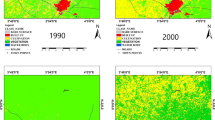Abstract
Land use and land cover changes are local and place specific, occurring incrementally in ways that often escape our attention. This study sought to detect changes in land cover in the Tema Metropolis of Ghana from 1990 to 2010. Multispectral Landsat Thematic Mapper data sets of 1990, 2000 and 2007 were acquired, pre-processed and enhanced. Unsupervised classification of the images was performed and six land cover classes (water, wetlands, closed vegetation, open vegetation, cropped lands, and built-up) were derived. The post-classification change detection technique was performed to derive the changes in land cover and their corresponding change matrices. Between 1990 and 2010, built-up areas expanded steadily to become the most prevalent land cover type in the metropolis, reducing vegetation cover dramatically. High population growth with its attendant rise in the demand for housing, and increasing commercial activities, were found to have influenced land cover changes over the period.




Similar content being viewed by others
References
Alberti, M., Weeks, R., & Coe, S. (2004). Urban land cover change analysis in Central Puget Sound. Photogrammetric Engineering and Remote Sensing, 70(9), 1043–1052.
Anderson, J. R., Hardy, E. E., Roach, J. T., & Witmer, D. R. E. (1976). A land use and land cover classification system for use with remote sensor data. Washington, DC: US Geological Survey.
Bektas, B. F., & Goksel, C. (2005). Analysing and mapping of Bozcaada Island land cover by means of remote sensing and GIS integration. In Proceedings of 25th EARSeL Symposium and Workshops, Porto, Portugal, 6–11 June 2005.
Campbell, J. B. (1987). Introduction to remote sensing. New York: The Guilford.
Chase, T. N., Pielke, R. A., Kittel, T. G., Nemani, R. R., & Running, S. W. (2000). Simulated impacts of historical land cover changes on global climate in northern winter. Climate Dynamics, 16(2), 93–105.
Chaudhary, B. S., Saroha, G. P., & Yadav, M. (2008). Human induced land use/land cover changes in northern part of Guragon district, Haryana, India. Natural resources census concept. Journal of Human Ecology, 23(3), 243–252.
DESA. (2009). World population prospects. The 2008 revision highlights. New York: United Nations.
DESA. (2010). World urbanisation prospects. The 2009 revision highlights. New York: United Nations.
Eastman, J. R. (2006). IDRISI Andes. Guide to GIS and image processing. Worcester, WA: IDRISI production.
Erle, E. (2010). Land-use and land-cover change. In Pontius, R. (Ed.), Encyclopedia of earth. Retrieved March 2, 2011, from http://www.eoearth.org/article/land-use_and_land-cover_change.
Fuller, R. A., & Gaston, K. J. (2009). The scaling of green space coverage in European cities. Biology Letters, 5(3), 352–355.
Geist, H. J., & Lambin, E. F. (2002). Proximate causes and underlying driving forces of tropical deforestation tropical forests are disappearing as the result of many pressures, both local and regional, acting in various combinations in different geographical locations. BioScience, 52(2), 143–150.
Ghana Statistical Service. (2002). 2000 Housing and population census report. GSS: Accra.
Goetz, S. J., Varlyguin, D., Smith, A. J., Wright, R. K., Prince, S. D., & Mazzacato, M. E. (2004). Application of multi-temporal Landsat data to map and monitor land cover and land use change in the Chesapeake Bay watershed. In Smits, P. C. & Bruzzone, L. (Eds.), In Proceedings of the second international workshop on the analysis of multi-temporal remote sensing images. Singapore: World Scientific Publishing Co.
Habitat, U. N. (2009). Planning sustainable cities—Policy directions. Global report on human settlements. United Nations Human Settlement Programme: London.
Houghton, R. A., Hackler, J. L., & Lawrence, K. T. (1999). The US carbon budget. Contribution from land use change. Science, 285(5427), 574–578.
Ingram, J. C., & Dawson, T. P. (2005). Inter-annual analysis of deforestation hotspots in Madagascar from high temporal resolution satellite observations. International Journal of Remote Sensing, 26(7), 1447–1461.
Intergovernmental Panel on Climate Change (2000). Land use, land use change, and forestry. Special report. Cambridge: Cambridge University Press.
Kasperson, J. X., Kasperson, R. E., & Turner, B. L. (Eds.). (1995). Regions at risk. Comparisons of threatened environments. Tokyo: United Nations University Press.
Lambin, E. F., Turner, B. L., Helmut, J. G., Agbola, S. B., Angelsen, A., Bruce, J. W., & Jianchu, X. (2001). The causes of land use and land cover changes: Moving beyond the myths. Global Environmental Change, 11(4), 261–269.
Lillesand, T. M., Kiefer, R., & Chipman, J. (2004). Remote sensing and image interpretation (5th ed.). New York: Wiley.
Rimal, B. (2011). Urban growth and land use/land cover change of Pokhara Sub-Metropolitan city, Nepal. Journal of Theoretical and Applied Information Technology, 26(22), 118–129.
Sala, O. E., Chapin, F. S., Armesto, J. J., Berlow, E., Bloomfield, J., Dirzo, R., & Huber-Sanwald, E. (2000). Biodiversity. Global biodiversity scenarios for the year 2100. Science, 287(5459), 1770–1774.
Small, C. (2004). Global population distribution and urban land use in geophysical parameter space. Earth Interctions, 8(8), 1–18.
Songsore, J. (2003). Towards a better understanding of urban change: Urbanization, national development and inequality in Ghana. Accra: Ghana Universities Press.
Southworth, J., & Tucker, C. (2001). The influence of accessibility, local institutions, and socioeconomic factors on forest cover change in the mountains of Western Honduras. Mountain Research and Development, 21(3), 276–283.
Squires, G. D. (2002). Urban sprawl and the uneven development of metropolitan America. Urban Policy Responses. Washington DC: Urban Institutes Press.
Yang, X. (2002). Satellite monitoring of urban spatial growth in the Atlanta Metropolitan area. Photogrammetric Engineering and Remote Sensing, 68(7), 725–734.
Yuan, F., Sawaya, K. E., Loeffelholz, B. C., & Bauer, M. E. (2005). Land cover classification and change analysis of the Twin cities (Minnesota) Metropolitan area by multitemporal Landsat remote sensing. Remote Sensing of Environment, 98(2), 317–328.
Author information
Authors and Affiliations
Corresponding author
Rights and permissions
About this article
Cite this article
Mariwah, S., Osei, K.N. & Amenyo-Xa, M.S. Urban land use/land cover changes in the Tema metropolitan area (1990–2010). GeoJournal 82, 247–258 (2017). https://doi.org/10.1007/s10708-015-9672-0
Published:
Issue Date:
DOI: https://doi.org/10.1007/s10708-015-9672-0




